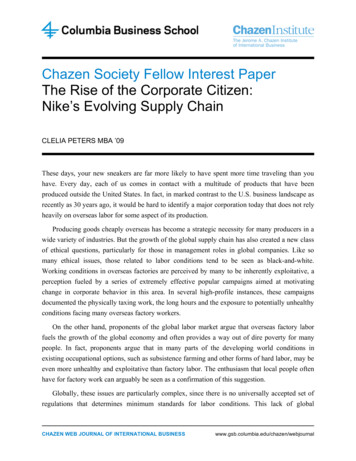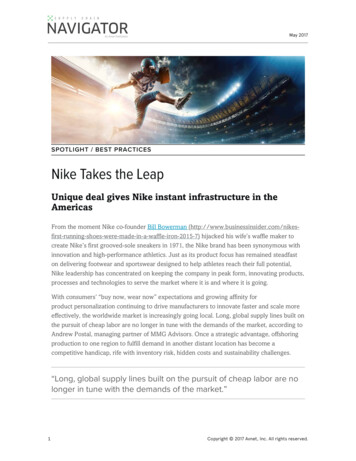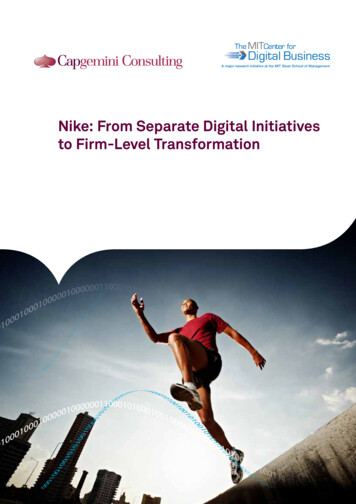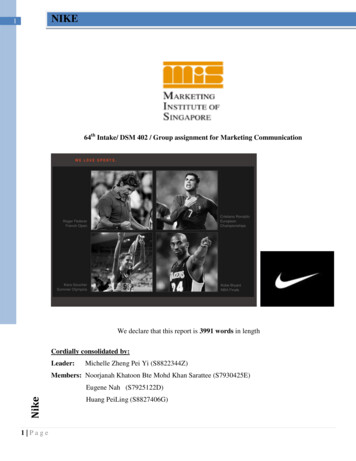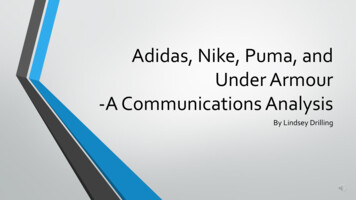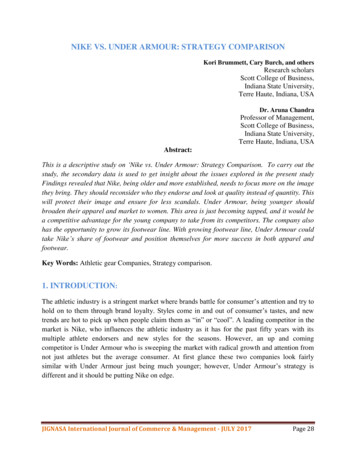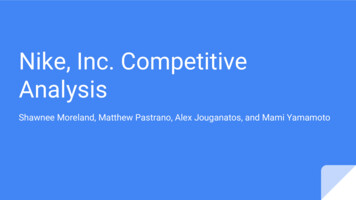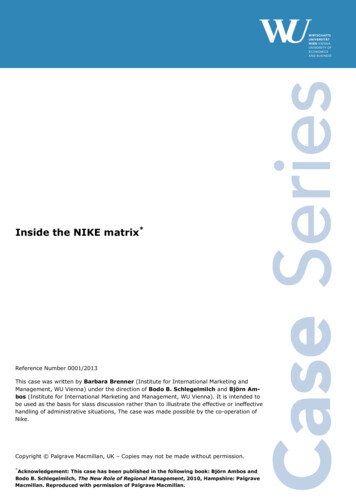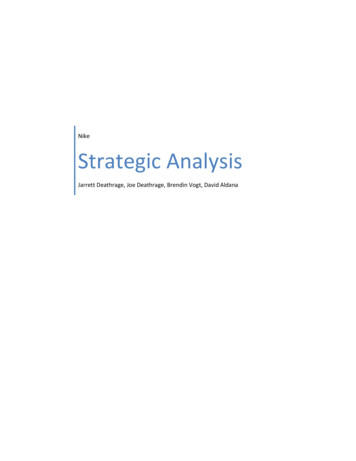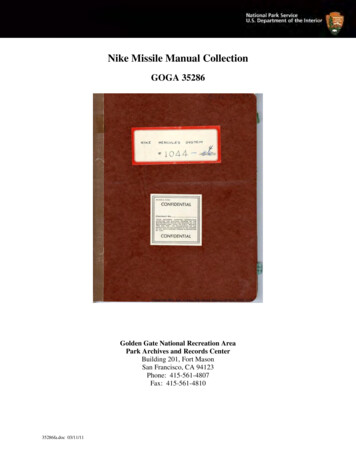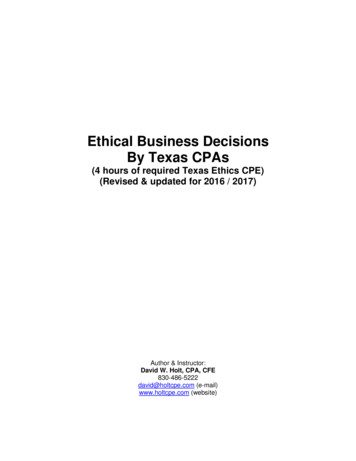
Transcription
Daniels Fund Ethics InitiativeUniversity of New Mexicohttp://danielsethics.mgt.unm.eduNike: Managing Ethical Missteps—Sweatshops to Leadership inEmployment PracticesINTRODUCTIONPhil Knight and his University of Oregon track coach Bill Bowerman founded Blue RibbonSports, later renamed Nike, in 1964. The idea, born as a result of a paper written by Knightduring his Stanford MBA program, was to import athletic shoes from Japan into the U.S.market, which was otherwise dominated by German competitors Puma and Adidas. Thecompany began as a distributor for a Japanese athletic shoe company, Onitsuka Tiger, butalso developed its own brand of athletic footwear to promote in the American market. Thecompany’s relationship with Onitsuka Tiger ended in 1971, and the Nike brand was createdin 1972 (named “Nike” after the Greek goddess of victory). The company as a whole wasrenamed Nike in 1978, and has since grown to be the largest worldwide seller of athleticgoods, with approximately 40,000 global employees and a presence in more than160countries.Nike was publicized by celebrity athlete sponsors. As the popularity of the Nike productgrew, so did the company’s manufacturing demands. In contrast to its meteoric rise in the1980s after going public, the late 1990s began a period of combating allegations about laborand human rights violations in Third World countries in which manufacturing had beensubcontracted. Nike’s response to this issue has been considered by critics to be morefocused on damage control than on a sincere attempt at labor reform.CRITICISMS OF NIKE’S MANUFACTURING PRACTICESIn order to remain competitive and keep manufacturing costs low, athletic footwearproduction has moved to areas of the world with low labor costs. Assembly of shoes (as wellas low-cost apparel, footwear, radios, TVs, toys, sporting goods equipment, and consumerelectronics) began shifting offshore in the 1960s, first to Japan, then to Korea and Taiwan,and then, beginning in the 1980s, to Southern China. By the mid-1980s Taiwan and Koreasupplied 45 percent of the world’s footwear exports, and production has continually shiftedto other Asian nations where the cost of manufacturing is lower still.This material was developed by O.C. Ferrell, Jennifer Jackson, and Jennifer Sawayda. Julian Mathias provided importantupdates. It is provided for the Daniels Fund Ethics Initiative at the University of New Mexico and is intended for classroomdiscussion rather than to illustrate effective or ineffective handling of administrative, ethical, or legal decisions bymanagement. Users of this material are prohibited from claiming this material as their own, emailing it to others, or placing iton the Internet. Please call O.C. Ferrell at 505-277-3468 for more information. (2014)
2Because of its history and experience with Japanese manufacturing and production, Nikewas a pioneer in overseas manufacturing as a way to cut costs on sports gearmanufacturing. When Japan became too expensive, Nike shifted its contracts to Vietnam,Indonesia, and China. The working conditions in these factories have been a source ofcontroversy. Allegations of poor conditions, child labor, widespread harassment, and abusehave all been issues for the company. Because the Asian factories have furthersubcontracted out the work, it has become increasingly difficult for Nike to keep track ofand regulate the working conditions and wages in these factories.Sweatshop labor is not merely an issue for Nike. It permeates the public consciousnessacross all manufacturing. Perhaps the incident that brought sweatshop labor to theforefront of American consciousness was the Kathy Lee Gifford debacle in 1996 when thehuman rights group the National Labor Committee uncovered that Gifford’s clothing linewas made in Honduran sweatshops that used child labor. As an industry leader, Nike’s highvisibility made it ripe for attack when labor rights violations were uncovered.Since the mid-1990s, Nike has faced a barrage of criticism from labor rights activists, themainstream media, and others for human and labor rights violations in its factories. Theaccusations have included deficiencies in health and safety conditions, extremely lowwages, and indiscriminate hiring and firing practices. While much of the firestorm has dieddown as Nike and other athletic wear manufacturers have sought to clean up their images,the criticism has damaged the company’s reputation.In Indonesia, where Korean suppliers owned a majority of Nike factories, reports by laboractivists and other nongovernmental organizations revealed several cases of human rightsabuses and labor violations. These conditions came to the attention of the general publicthrough stories such as Roberta Baskin’s CBS report on the conditions in Nike’smanufacturing facilities in Indonesia in 1993.In 1996 Life magazine published an exposé complete with photos of Pakistani childrenstitching soccer balls for Nike, Adidas AG, and other companies. The images of thesechildren had a devastating impact on Nike’s sales and corporate reputation. Customers whohad previously held the American athletics brand in high regard began to develop a loweropinion of the company. Bob Herbert’s op-ed article in The New York Times in 1996 led tofurther public interest in this issue, and protests and demonstrations were held all over theUnited States. Several demonstrations occurred at “Nike Towns,” the Nike retail megastores.Nike also experienced problems with factory conditions in Vietnam. A private report on oneof its factories commissioned by Nike as part of an audit by Ernst and Young was leaked tothe press, and The New York Times ran it as a front-page article. The audit reportedunacceptable levels of exposure to chemicals in the factory and documented cases ofresulting employee health problems, as well as other infringements of the established codeof conduct.
3In response to the criticisms raised during the 1990s, Nike had to take rapid measures notonly to redeem its reputation, but also to rectify problematic policies and lack ofinternational oversight of its operations. Nike’s new priorities became to make certain thatits factories were not taking advantage of its workers and to ensure that each worker had asafe work environment and competitive wage.ENVIRONMENTAL PROBLEMS RELATED TO THE TEXTILE INDUSTRYBecause of the nature of the textile industry, Nike faces numerous challenges andpotentially critical problems. The textile industry negatively impacts the environmentwherever manufacturing is located. Problems generated by the textile industry in general,and Nike specifically, include increased water deficits; climate change; pollution of land, air,and waterways; and large fossil fuel and raw material consumption. In addition to theseenvironmental hazards, today’s electronic textile plants expend significant amounts ofenergy. All of these issues are exacerbated by Western culture, where fashions are popularfor only a few months before being discarded.In addition to environmental considerations, textile manufacturers must consider theiremployees’ working conditions. The demand for cheap labor and lax labor laws indeveloping countries such as Vietnam, China, and Indonesia have led to an increasedprevalence of child labor and abusive practices. In her book No Logo, Naomi Klein claimsthat Nike abandons manufacturing sites when countries begin to work toward developingbetter pay and employment rights. Nike’s critics believe the company should improvetransparency measures in its factories, allow independent inspection to verify conditions,and disclose all audits to the public. Nike has complied with these demands to a limitedextent. For example, audits of Nike generally have determined that Nike pays wages abovethe legal minimum. Critics are not satisfied, however, arguing that in most cases the wagesstill do not constitute a fair living wage.In response, Nike claimed that sharing factory locations with independent third parties on aconfidential basis enables the company to monitor its supply chain properly. It stated thatdisclosure of the factory names, plus details of audits of those factories, would be used byNGOs simply to make further attacks rather than as a way to help the company address andresolve problems. Nike also stated that establishing what constitutes a “fair” wage isdifficult given the fact that costs of living and economic conditions vary from country tocountry.NIKE RESPONDS TO CHALLENGESPublic protests against Nike took the form of boycotts and picketing of Nike stores.Universities cancelled their deals with Nike to produce branded athletic goods. In 1998 Nikerevenues and stock prices decreased by approximately 50 percent, and the company laid off1,600 workers. Nike launched a large public relations campaign to combat the damaging
4allegations of child labor, inhospitable working conditions, and low or nonexistent wages. Inan effort to directly address the concerns of student activists, Nike visited several collegecampuses, opening dialog with students and university administrations about itsmanufacturing policies. Nike even invited teams of Dartmouth graduate students to tour theIndonesian and Vietnamese factories for three weeks at Nike’s expense.The company has spent considerable resources focusing on improving the labor standardsin each of its factories. It must weigh the expense of labor in nations where productmanufacturing is available. However, because these factories subcontract out to the localworkforce, it is difficult for Nike to regulate the working environment. Nike must take extrameasures to ensure that the independent subcontractors used to supply the workforce intheir factories do not engage in any illegal activities such as child labor, excessive workhours, hostile work environments, or inappropriate payments.Nike also has implemented a code of conduct for all of its suppliers, and has been workingwith the Global Alliance to help review its factories. In August 1996 Nike Corporation joinedthe Apparel Industry Partnership, a coalition of companies and labor and human rightsgroups assembled by the Clinton administration, to draft an industry-wide code of conduct.Since universities form a core segment of Nike’s market and the company felt therepercussions of its manufacturing practices in the form of several canceled universitycontracts, Nike sent letters detailing the acceptable conditions in its factories and stressingits commitment to corporate responsibility to universities around the country.Representatives from Nike also visited campuses and spoke to students, assuring them ofNike’s intention to be a responsible corporate citizen. Phil Knight himself visited the campusof the University of North Carolina at Chapel Hill. Nike also launched a public relationscampaign that included writing op-ed pieces, letters to the editor, and press releases todefend its reputation and to refute critics’ claims.However, Marc Kasky, a California activist, maintained that Nike’s claims were misleadingand deceptive to the public. He filed a lawsuit claiming that Nike’s actions should beclassified as commercial speech that violated California’s unfair competition and advertisinglaws. The legal controversy culminated in the California Supreme Court’s decision in Kaskyv. Nike. The court determined that public relations communications may constitute“commercial speech” that can be interpreted as “false advertising.” As commercial speech isafforded less protection under the First Amendment, Nike would be liable for any claimsunder its public relations campaign that could be construed as misleading the public. Afterthe ruling, Nike settled the lawsuit at approximately 2 million.NIKE’S CORPORATE SOCIAL RESPONSIBILITYNike’s corporate social responsibility (CSR) practices have been evolving since 1991. Atfirst, Nike’s approach to CSR could be characterized as insufficient and generally lacking in
5any true forms of regulation and implementation throughout its global supply chain.Manufacturers in foreign locations were simply trying to comply with the minimal contractrequirements, while at times overlooking fair labor practices in order to perform as lowcost suppliers. Nike’s initial response to criticism was reputation management rather thanwide-scale changes in its practices. However, as more issues have surfaced and beenbrought to the attention of the corporation and its consumers, Nike has increased its effortsto be more ethical in its manufacturing practices. In fact, it has become something of anindustry leader in certain areas. This does not mean the company is totally free fromcriticism. For instance, in 2013 the company was criticized for releasing an online adfeaturing Tiger Woods with the slogan “winning takes care of everything.” Many thought theadvertisement was inappropriate considering the controversy surrounding Tiger Woods’past behavior. Yet Nike has significantly altered its factory oversight and appearscommitted to its social responsibility initiatives.According to Harvard University senior fellow Simon Zadek, corporate responsibilityevolves through five stages:1.Defensive: “It’s not our fault.”2.Compliance: “We’ll do only what we have to.”3.Managerial: “It’s the business.”4.Strategic: “It gives us a competitive edge.”5.Civil: “We need to make sure everybody does it.”Nike could be classified as having evolved from the defensive stage through the compliancestage to the managerial stage. The company’s first CSR report demonstrated how Nike hadhandled complaints from stakeholders who wanted to see better working conditions atNike’s contract factories. In its 2005 report, the company provided the names and locationsof factories that produced its products for the first time ever. In its third CSR report, Nikeofficials said they were moving away from using corporate responsibility as a crisismanagement tool and would instead be using it as an opportunity for innovation and
management. Users of this material are prohibited from claiming this material as their own, emailing it to others, or placing it on the Internet. Please call O.C. Ferrell at 505-277-3468 for more information. (2014) Nike: Managing Ethical Missteps— Sweatshops to Leadership in Employment Practices INTRODUCTION Phil Knight and his University of Oregon track coach Bill Bowerman founded Blue .File Size: 521KBPage Count: 11

